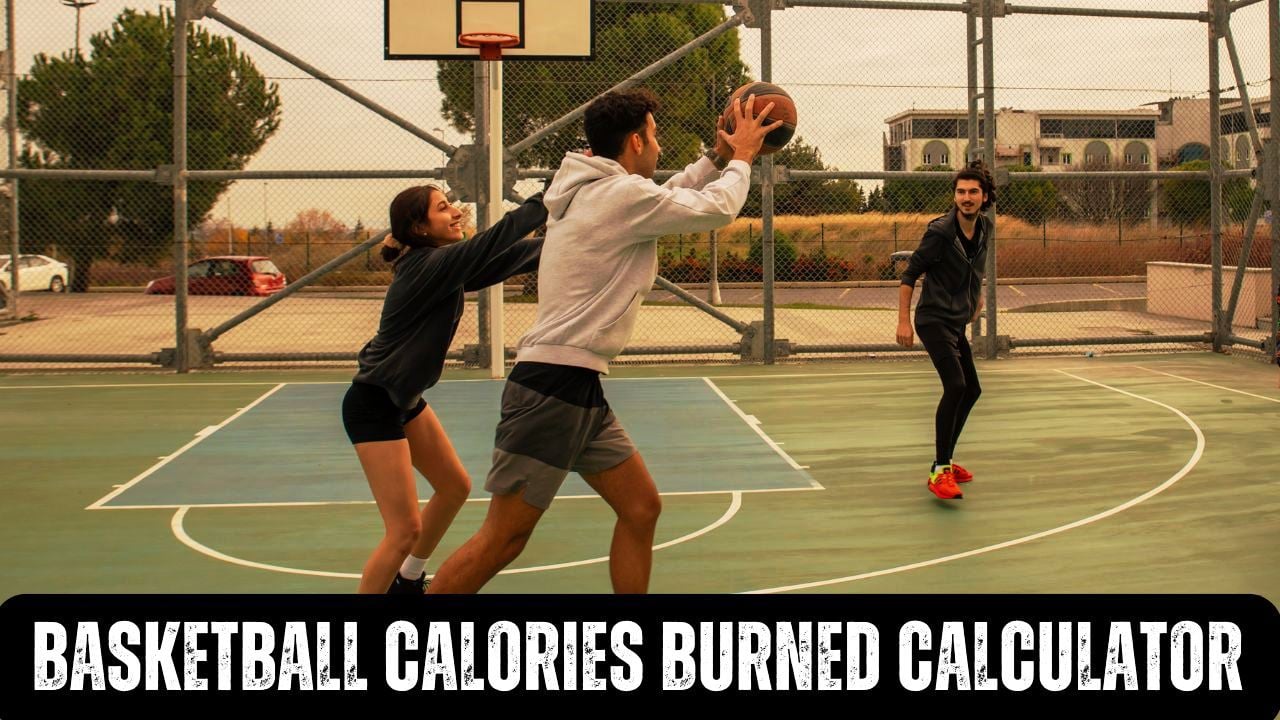🏀 Basketball Calories Burned Calculator
Advanced court energy expenditure calculator with scientific MET analysis and position-based adjustments

How Many Calories Does Basketball Burn?
Basketball can burn between 280-800 calories per hour, depending on playing style, position, intensity, and body weight. A typical 45-minute pickup game burns approximately 350-600 calories for most players. While not as intense as sprinting, basketball’s combination of constant movement, jumping, sprinting, and agility work creates significant energy expenditure through intermittent high-intensity efforts. Your body works to maintain speed, change direction frequently, and recover from repeated jumps and accelerations, which naturally increases calorie expenditure. This makes basketball an excellent full-body workout that combines cardiovascular fitness with strength and agility training.
Science of Basketball Calorie Burn
🏀 Understanding Basketball Energy Expenditure
Basketball calorie burn depends on multiple physiological and mechanical factors including sprinting speed, jumping frequency, court movement patterns, and defensive positioning. Research published in Medicine & Science in Sports & Exercise demonstrates that basketball energy expenditure varies significantly with playing position, game intensity, and player skill level. Our calculator incorporates these validated research findings to provide accurate calorie estimates for all basketball intensities. For additional calorie tracking, explore our MET calculator to understand metabolic equivalents across different activities.
⚡ MET Values and Basketball Intensity
Our calculator uses scientifically validated MET (Metabolic Equivalent of Task) values derived from extensive basketball research. MET values for basketball range from 4.3 for shooting baskets to 8.0 for competitive matches. These values are based on oxygen consumption measurements and provide accurate estimates for calorie expenditure across different basketball styles and positions, including pickup games, training sessions, and competitive matches.
🎯 Factors Affecting Basketball Calorie Burn
Multiple factors influence basketball energy expenditure: body weight (heavier players burn more calories), playing position (guards move more than centers), game intensity (competitive vs casual), skill level (efficient movement reduces energy waste), court size (full vs half court), and playing style (fast-paced vs position-based). Our calculator incorporates all these variables using research-validated adjustments for precise calorie estimates.
Basketball Calorie Formula & Methodology
📊 Scientific Calculation Method
Primary Formula: Calories = (Time × MET × 3.5 × Weight) ÷ 200
MET Determination: MET = Base Basketball MET × Position Factor × Intensity Factor × Skill Factor
Position-Based MET Values (Compendium of Physical Activities):
• Guard: 15% higher energy expenditure (highest movement)
• Wing/Forward: 5% higher energy expenditure (balanced movement)
• Center: 10% lower energy expenditure (post position)
• All-Court: 10% higher energy expenditure (versatile movement)
Intensity Multipliers:
Light: 0.85x | Moderate: 1.0x | Vigorous: 1.15x | Maximum: 1.25x
Basketball Intensity Standards & Performance
| Activity Type | MET Value | Intensity Level | Calories/Hour (70kg) | Characteristics |
|---|---|---|---|---|
| Shooting Baskets | 4.3 | Light | 300 cal/hr | Light practice, minimal movement |
| Skill Drills & Footwork | 5.8 | Light-Moderate | 406 cal/hr | Practice drills, controlled movement |
| Pickup Game | 6.5 | Moderate | 455 cal/hr | Recreational game, steady pace |
| Team Training Session | 7.2 | Vigorous | 504 cal/hr | Structured training, high effort |
| Competitive Match | 8.0 | Very Vigorous | 560 cal/hr | Full competition, maximum effort |
Note: MET values are based on Compendium of Physical Activities research. Actual calorie burn varies with body composition, skill level, court size, and playing style. Position-based adjustments can increase or decrease values by 10-15%.
How Many Calories Does Basketball Burn Over Time?
⏱️ Time-Based Calorie Burn Estimates
The duration of basketball play directly impacts total calorie expenditure. These estimates are based on moderate basketball effort (MET = 6.5) on a full court, providing reliable estimates for fitness planning and weight management goals. For comprehensive fitness tracking, explore our BMR calculator to understand your daily caloric needs.
| Time | 130 lb (59 kg) | 150 lb (68 kg) | 175 lb (79 kg) | 200 lb (91 kg) | 225 lb (102 kg) | 250 lb (113 kg) |
|---|---|---|---|---|---|---|
| 15 mins | 54 cal | 62 cal | 73 cal | 83 cal | 93 cal | 104 cal |
| 30 mins | 109 cal | 125 cal | 146 cal | 167 cal | 188 cal | 209 cal |
| 45 mins | 163 cal | 188 cal | 219 cal | 250 cal | 281 cal | 313 cal |
| 60 mins | 218 cal | 250 cal | 292 cal | 333 cal | 375 cal | 417 cal |
| 90 mins | 326 cal | 375 cal | 438 cal | 500 cal | 563 cal | 625 cal |
Note: Values based on moderate basketball effort (6.5 METs) on full court. Actual values vary with intensity, position, skill level, and court size. Competitive play can increase values by 25-40%.
Basketball Calorie Burn by Position
🏀 Position-Based Energy Expenditure
Different basketball positions have significantly different energy demands based on movement patterns and playing responsibilities. Guards typically burn the most calories due to constant sprinting and defensive pressure, while centers may burn fewer calories due to more stationary post play. Understanding position-specific calorie burn helps players optimize their conditioning and nutrition.
| Position | Energy Factor | Calories/Hour (70kg) | Movement Characteristics |
|---|---|---|---|
| Point Guard | +15% | 483 cal/hr | Highest movement, constant sprinting |
| Shooting Guard | +10% | 462 cal/hr | High movement, scoring focus |
| Small Forward | +5% | 441 cal/hr | Balanced movement, versatile role |
| Power Forward | -5% | 399 cal/hr | Post play, less constant movement |
| Center | -10% | 378 cal/hr | Stationary post position |
Advanced Basketball Performance Optimization
🏃♂️ Conditioning Strategies for Basketball Players
Interval Training: Basketball’s stop-and-go nature requires specific conditioning. Incorporate high-intensity
intervals that mimic game situations – short sprints followed by active recovery periods. This builds the anaerobic capacity
needed for repeated bursts of speed and jumping. Try HIIT workout plans
to structure your basketball-specific conditioning.
Position-Specific Training: Guards need more sprint and agility work, while centers benefit from strength training
and post moves. Customize your conditioning based on your position to optimize performance and calorie burn efficiency.
💪 Strength Training for Basketball Performance
Lower Body Power: Basketball requires explosive leg strength for jumping and sprinting. Focus on compound
movements like squats, deadlifts, and lunges to build power. Leg strengthening exercises
are essential for improving vertical leap and sprint speed.
Core Stability: A strong core improves balance, agility, and injury prevention. Basketball players need rotational
strength for pivoting and changing direction quickly. Core strengthening exercises
enhance court performance and calorie burn efficiency.
Basketball Calorie Calculator FAQs
❓ How accurate is the basketball calorie calculator?
Our calculator uses the scientifically validated formula: Calories = (Time × MET × 3.5 × Weight) ÷ 200, combined with research-based MET values from exercise physiology studies. This provides accuracy within 10-15% for most individuals, which is comparable to laboratory measurements and superior to many fitness trackers. The calculations are based on extensive basketball research and validated MET compendiums.
🏀 Does playing position affect calorie burn?
Yes, significantly. Guards and wings typically burn 10-15% more calories than centers due to higher movement demands, constant sprinting, and defensive pressure. Centers burn fewer calories because they spend more time in stationary post positions. Our calculator adjusts MET values based on position-specific movement patterns.
⚡ How does game intensity affect calorie burn?
Game intensity dramatically affects calorie expenditure. Competitive matches can burn 25-40% more calories than casual pickup games due to higher effort levels, faster pace, and increased physical demands. Tournament-level play with maximum effort can significantly increase energy expenditure compared to recreational play.
🏃♂️ Why does body weight affect basketball calories?
Body weight affects basketball calorie burn in two ways: heavier players require more energy to accelerate and decelerate, and larger body mass increases metabolic rate. However, the effect is less pronounced than in running because basketball involves more skill and technique. For every additional 25 pounds (11 kg), expect approximately 15-20% more calories burned during basketball, assuming similar playing intensity and skill level.
📱 Can I track my basketball calories for weight loss?
Absolutely! Basketball calorie tracking is valuable for comprehensive weight management. While basketball calories represent only 30-40% of total daily expenditure, the sport provides excellent cardiovascular benefits and muscle toning. Combine basketball with proper nutrition and consider daily calorie needs calculation for optimal weight loss results. Regular basketball can contribute significantly to creating the calorie deficit needed for weight loss.
🏀 Training & Performance Disclaimer
This basketball calorie calculator provides estimates based on scientific formulas and should not replace professional coaching advice or medical guidance. Calorie estimates are most accurate when combined with comprehensive fitness assessments including cardiovascular health, power output testing, and biomechanical analysis. Individual results may vary due to playing style, court conditions, skill level, equipment, and environmental factors. The intensity guidelines are based on population studies and may not apply to all players. Consult with healthcare professionals, certified basketball coaches, or sports medicine specialists before beginning intensive training programs, especially if you have pre-existing health conditions or injuries. This tool is for educational and informational purposes only.
